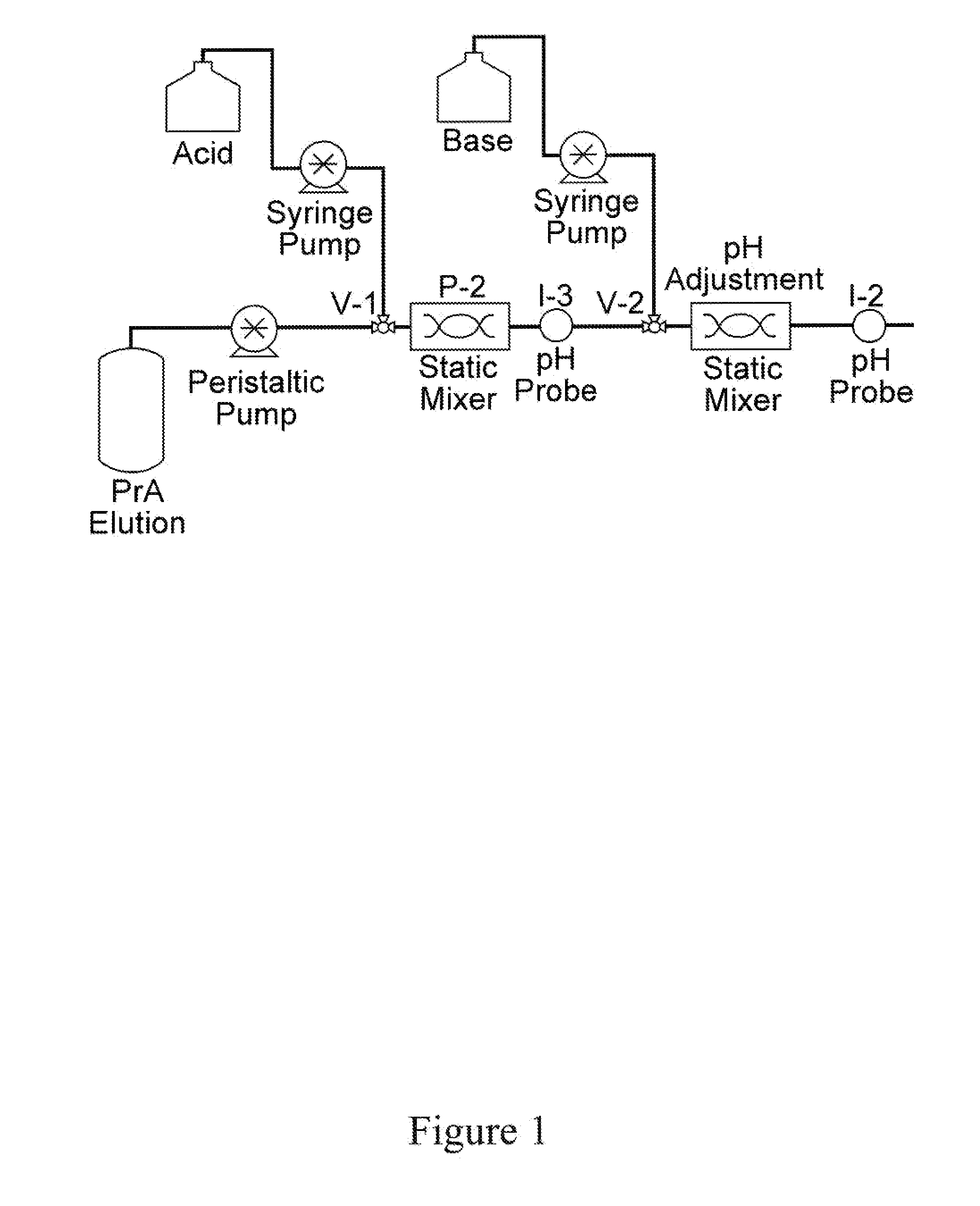Methods for Inactivating Viruses During a Protein Purification Process
a protein purification and virus technology, applied in the direction of viruses/bacteriophages, separation processes, peptides, etc., to achieve the effect of reducing the overall footprint of the whole purification process, reducing the overall physical space required, and reducing the overall time required for virus inactivation
- Summary
- Abstract
- Description
- Claims
- Application Information
AI Technical Summary
Benefits of technology
Problems solved by technology
Method used
Image
Examples
example 1
Time Dependence of X-MuLV Low-pH Virus Inactivation in Test Tubes
[0133]In this representative experiment, a retrovirus spiked into a solution containing a MAb is inactivated by short-time incubation at low pH. The goal of the experiment is to understand the pH and exposure time required for complete retrovirus inactivation in a solution containing high concentrations of protein (antibody). The minimal time required to inactivate X-MuLV is determined at pH's ranging from 3.1-3.5. The experiment is performed in test tubes. The maximum experimental time tested for inactivation is five minutes using a static mixer.
[0134]The sample used is 20 mg / ml, polyclonal IgG (Seracare) in 50 mM sodium acetate buffer at pH 5.3. The predilution used to avoid cytotoxicity from the buffer is 1 / 50. In order to meet the target of LRV >4. X-MuLV stock of titer 7.0 TCID50 / mL is used to spike feed to 6.0 log TCID50 / mL (˜10% spike). Accounting for the 1 / 50 predilution and the ˜1 / 5 dilution of the material in...
example 2
Time Dependence of X-MuLV Low-pH Virus Inactivation in Test Tubes for Both polyclonal and Monoclonal Antibodies
[0136]In this representative experiment, the same protocol as described in Example 1 is followed, in order to better understand at what pH there is no virus inactivation, or alternatively, the minimum pH1 where there is inactivation.
[0137]Both polyclonal IgG (Seracare) and two monoclonal antibodies (MAb05 and MAb04) produced in CHO cells are used. The results are summarized in Table III below, where the results with “≧” indicate that no virus is detected in the sample.
TABLE IIIMab5MAb04SeracareSeracaretimeLRV @timeLRV @timeLRV @timeLRV @(min)pH 3.7(min)pH 3.7(min)pH 4(min)pH 51.33.27 1.42.51100.51 1002.33.452.3 2.9 201.0120053.545 3.130 1.01 30010≧4.310≧4.0451.01450.1360 1.26600
[0138]As results in Table III indicate that half a minute is adequate for virus inactivation at pH 3.3. Increasing the pH to 3.6 extends the time needed to 1.1 minutes. Ten minutes are required at pH...
example 3
Time Dependence of X-MuLV Low-pH Virus Inactivation with Static Mixers
[0139]In this representative experiment, the pH and exposure time required for complete retrovirus inactivation in a high protein (MAb) feed solution using static mixers is investigated.
[0140]Based on the results in Example 1, the possibility of inactivating a retrovirus using in-line static mixers is investigated. The pH of the solution is lowered as it flows through a channel by injection of acid at a rate calculated for reducing the pH to 3.4. At the downstream end of the channel, the pH is adjusted back to neutral for the next step in the process. This experiment determines the exposure time needed to inactivate X-MuLV using an in-line technique. The experimental setup is shown in FIG. 1.
[0141]The sample used is 9.9 g / L polyclonal IgG (Seracare) in 20 mM acetic acid buffer at pH 5.0. The feed spiked with virus is passed through the experimental set-up shown in FIG. 1 for in-line pH inactivation. The set-up con...
PUM
| Property | Measurement | Unit |
|---|---|---|
| time | aaaaa | aaaaa |
| pH | aaaaa | aaaaa |
| pH | aaaaa | aaaaa |
Abstract
Description
Claims
Application Information
 Login to View More
Login to View More - R&D
- Intellectual Property
- Life Sciences
- Materials
- Tech Scout
- Unparalleled Data Quality
- Higher Quality Content
- 60% Fewer Hallucinations
Browse by: Latest US Patents, China's latest patents, Technical Efficacy Thesaurus, Application Domain, Technology Topic, Popular Technical Reports.
© 2025 PatSnap. All rights reserved.Legal|Privacy policy|Modern Slavery Act Transparency Statement|Sitemap|About US| Contact US: help@patsnap.com

